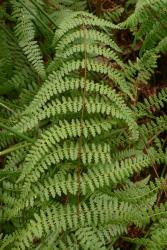Terrestrial ferns. Rhizomes long-creeping, bearing red-brown or pale brown multicellular hairs. Fronds monomorphic, indeterminate with intermittent growth (not NZ) or determinate. Stipes hairy, spiny (not NZ) or rough. Laminae 2–4-pinnate, coriaceous, bearing non-glandular hairs, adaxial sulci of rachis and primary costae confluent; primary pinnae stalked, arising from rachis at ±90º, stipule-like pinnules present around resting buds of indeterminate fronds or absent. Veins free, reaching the lamina margin at indentations (NZ) or terminating at ± straight margin (not NZ). Sori round or elliptic, superficial, submarginal or submedial; paraphyses absent. Indusia either absent, or formed from partially reflexed, toothed lamina flaps, opening inwards; inner indusium absent. Spores monolete, echinate (not NZ) or smooth.
Hiya was distinguished by Shang et al. (2018) as a small genus of three species previously included within Hypolepis. However, Perrie et al. (2018) showed from a phylogenetic analysis of chloroplast DNA sequences that the Australasian H. distans was also embedded within Hiya, necessitating a revision of the generic description. Perrie et al. (2018) distinguished Hiya from Hypolepis on the basis that the adaxial sulci of the primary costae were confluent with the rachis, the lamina veins reached the margin at an indentation or where the margin was ± straight, and the basal primary pinnae arose from the rachis at ± 90º. By contrast, in Hypolepis, the adaxial sulci of the primary costae were not confluent with the rachis, the lamina veins reached the margin where it was convex, and the basal primary pinnae arose from the rachis at an acute angle.
Hiya is distinguished from other genera of Dennstaedtiaceae by its sori that are ± round and situated near the lamina margins, the adaxial sulci of the primary pinnae that are confluent with the rachis, its veins that often reach the margin at an indentation, and its basal pinnae that arise at c. 90º to the rachis.
A genus of four species with one in the Neotropics from Mexico to Guyana and Bolivia, two in Malesia from peninsular Malaysia, Borneo, Sulawesi, Flores and New Guinea, and one in temperate Australia and New Zealand (Shang et al. 2018; Perrie et al. 2018). One non-endemic species in New Zealand.
| Category | Number |
|---|---|
| Indigenous (Non-endemic) | 1 |
| Total | 1 |
The base chromosome number in Hiya is x = 28 or 29 (Brownsey 1983; Brownsey & Chinnock 1984).




